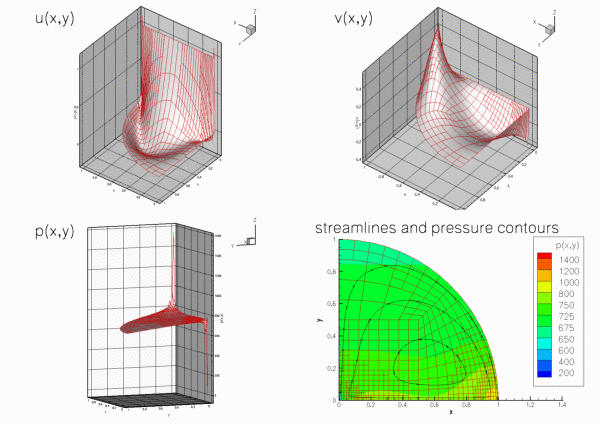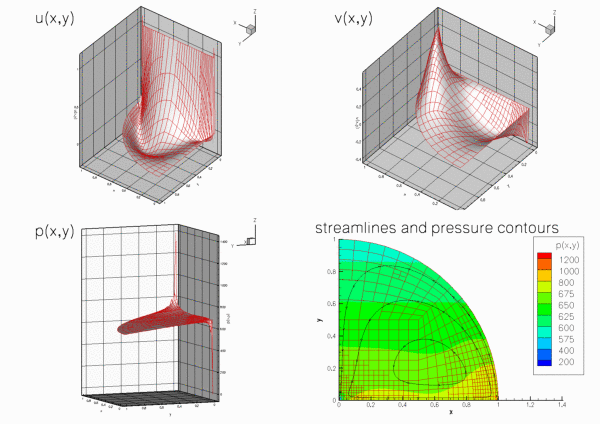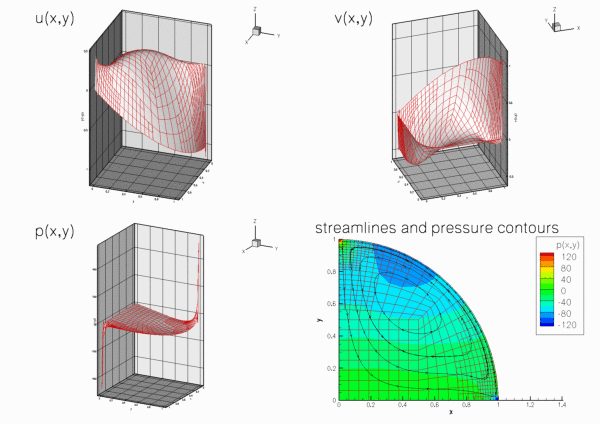In this example we shall demonstrate
- how easy it is to adapt the code for the solution of the driven cavity problem in a square domain, discussed in a previous example , to a different domain shape,
- how to apply body forces (e.g. gravity) in a Navier-Stokes problem,
- how to switch between the stress-divergence and the simplified forms of the incompressible Navier-Stokes equations.
The example problem
In this example we shall illustrate the solution of the steady 2D Navier-Stokes equations in a modified driven cavity problem: The fluid is contained in a quarter-circle domain and is subject to gravity which acts in the vertical direction. We solve the problem in two different formulations, using the stress-divergence and the simplified form of the Navier-Stokes equations, respectively, and by applying the gravitational body force via the gravity vector, ![]() , and via the body force function,
, and via the body force function, ![]() , respectively.
, respectively.
using the stress-divergence form of the Navier-Stokes equations Solve
and
in the quarter-circle domain
on the curved and left boundaries; and
on the bottom boundary, |
When discussing the implementation of the Navier-Stokes equations in an earlier example , we mentioned that oomph-lib allows the incompressible Navier-Stokes equations to be solved in the simplified, rather than the (default) stress-divergence form. We will demonstrate the use of this feature by solving the following problem:
|
using the simplified form of the Navier-Stokes equations Solve
and
in the quarter-circle domain
on the curved and left boundaries; and
on the bottom boundary, |
Note that in Problem 2, the gravitational body force is represented by the body force rather than the gravity vector.
Switching between the stress-divergence and the simplified forms of the Navier-Stokes equations
The two forms of the Navier-Stokes equations differ in the implementation of the viscous terms, which may be represented as
![]()
For an incompressible flow, ![]() , both forms are mathematically equivalent but the stress-divergence form is required for problems with free surfaces , or for problems in which traction boundary conditions are to be applied.
, both forms are mathematically equivalent but the stress-divergence form is required for problems with free surfaces , or for problems in which traction boundary conditions are to be applied.
In order to be able do deal with both cases, oomph-lib's Navier-Stokes elements actually implement the viscous term as
![]()
By default the components of the vector ![]() , are set to 1.0, so that the stress-divergence form is used. The components
, are set to 1.0, so that the stress-divergence form is used. The components ![]() are stored in the static data member
are stored in the static data member
of the NavierStokesEquations<DIM> class which forms the basis for all Navier-Stokes elements in oomph-lib. Its entries are initialised to 1.0. The user may over-write these assignments and thus re-define the values of ![]() being used for a specific problem. [In principle, it is possible to use stress-divergence form for the first component of the momentum equations, and the simplified form for the second one, say. However, we do not believe that this is a particularly useful/desirable option and have certainly never used such (slightly bizarre) assignments in any of our own computations.]
being used for a specific problem. [In principle, it is possible to use stress-divergence form for the first component of the momentum equations, and the simplified form for the second one, say. However, we do not believe that this is a particularly useful/desirable option and have certainly never used such (slightly bizarre) assignments in any of our own computations.]
Solution to problem 1
The figure below shows "carpet plots" of the velocity and pressure fields as well as a contour plot of the pressure distribution with superimposed streamlines for Problem 1 at a Reynolds number of ![]() and a ratio of Reynolds and Froude numbers (a measure of gravity on the viscous scale) of
and a ratio of Reynolds and Froude numbers (a measure of gravity on the viscous scale) of ![]() . The velocity vanishes along the entire domain boundary, apart from the bottom boundary
. The velocity vanishes along the entire domain boundary, apart from the bottom boundary ![]() where the moving "lid" imposes a unit tangential velocity which drives a large vortex, centred at
where the moving "lid" imposes a unit tangential velocity which drives a large vortex, centred at ![]() . The pressure singularities created by the velocity discontinuities at
. The pressure singularities created by the velocity discontinuities at ![]() and
and ![]() are well resolved. The pressure plot shows that away from the singularities, the pressure decreases linearly with
are well resolved. The pressure plot shows that away from the singularities, the pressure decreases linearly with ![]() , reflecting the effect of the gravitational body forces which acts in the negative
, reflecting the effect of the gravitational body forces which acts in the negative ![]() direction.
direction.

Solution to problem 2
The next figure shows the computational results for Problem 2, obtained from a computation with adaptive Crouzeix-Raviart elements.

The code
We use a namespace Global_Physical_Variables to define the various parameters: The Reynolds number,
the gravity vector ![]() , and the ratio of Reynolds and Froude number,
, and the ratio of Reynolds and Froude number, ![]() , which represents the ratio of gravitational and viscous forces,
, which represents the ratio of gravitational and viscous forces,
In Problem 2, gravity is introduced via the body force function ![]() which we define such that Problems 1 and 2 are equivalent. (We use the gravity vector
which we define such that Problems 1 and 2 are equivalent. (We use the gravity vector ![]() to specify the direction of gravity, while indicating it magnitude by
to specify the direction of gravity, while indicating it magnitude by ![]() )
)
Finally we define a body force function, which returns zero values, for use when solving Problem 1.
The driver code
First we create a DocInfo object to control the output, and set the maximum number of spatial adaptations to three.
To solve problem 1 we define the direction of gravity, ![]() , and set the entries in the
, and set the entries in the NavierStokesEquations<2>::Gamma vector to ![]() , so that the stress-divergence form of the equation is used [In fact, this step is not strictly necessary as it simply re-assigns the default values.]
, so that the stress-divergence form of the equation is used [In fact, this step is not strictly necessary as it simply re-assigns the default values.]
Next we build problem 1 using Taylor-Hood elements and passing a function pointer to the zero_body_force(...) function (defined in the namespace Global_Physical_Variables) as the argument.
Now problem 1 can be solved as in the previous example.
To solve problem 2 we set the entries in the NavierStokesEquations<2>::Gamma vector to zero (thus choosing the simplified version of the Navier-Stokes equations), define ![]() , and pass a function pointer to the
, and pass a function pointer to the body_force(...) function to the problem constructor.
Problem 2 may then be solved as before.
The problem class
The problem class is very similar to that used in the previous example , with two exceptions:
- We pass a function pointer to the body force function
 to the constructor and
to the constructor and - store the function pointer to the body force function in the problem's private member data.
The problem constructor
We store the function pointer to the body force function in the private data member Body_force_fct_pt.
As usual the first task is to create the mesh. We now use the RefineableQuarterCircleSectorMesh<ELEMENT>, which requires the creation of a GeomObject to describe geometry of the curved wall: We choose an ellipse with unit half axes (i.e. a unit circle).
Next the error estimator is set, the boundary nodes are pinned and the Reynolds number is assigned, as before .
Within this loop we also pass the pointers to ![]() , the gravity vector and the body-force function to the elements.
, the gravity vector and the body-force function to the elements.
The RefineableQuarterCircleSectorMesh<ELEMENT> contains only three elements and therefore provides a very coarse discretisation of the domain. We refine the mesh uniformly twice before pinning the redundant pressure degrees of freedom, pinning a single pressure degree of freedom, and assigning the equation numbers, as before.
Post processing
The post processing function remains the same as in the previous examples .
Comments and Exercises
- Try making the curved boundary the driving wall [Hint: this requires a change in the wall velocities prescribed in
Problem::actions_before_newton_solve(). The figure below shows what you should expect.]

Source files for this tutorial
- The source files for this tutorial are located in the directory:
demo_drivers/navier_stokes/circular_driven_cavity/ - The driver code is:
demo_drivers/navier_stokes/circular_driven_cavity/circular_driven_cavity.cc
PDF file
A pdf version of this document is available. \